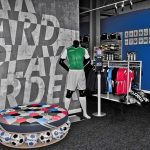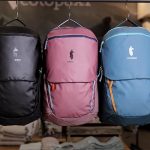In reporting results last week for the first half, JD Sports indicated the company was moving full-steam ahead with plans to test the JD flagship concept in the U.S. while leveraging its merchandising talents on Finish Line locations. One U.K. analyst, Jonathan Pritchard at Peel Hunt, believes JD Sports can deliver on its potential to shake up U.S. sneaker retailing..
“We understand that U.K. retailers have failed in the U.S. before,” wrote Pritchard in a 70-page report. “But JD is bringing financial clout and deeper brand relationships to a workable store portfolio, and will, in our view, succeed Stateside.”
On June 18, JD Sports acquired The Finish Line Inc. for cash consideration of $558 million (£400.5 million). With nearly 1,300 stores in the U.K. and Europe, JD Sports is seen as the premier seller of sneakers in the U.K. with the JD chain.
Pritchard rates JD’s stock a “Buy” and believes shares have been held back in part due to concerns tied to past challenges U.K. chains have faced expanding into the U.S. Shortfalls have included Tesco’s failed experiment with the Fresh & Easy grocery concept in California, Marks & Spencer’s challenges with Brooks Brothers as well as botched entries from Sainsbury, WH Smith, Dixons and HMV.
But Pritchard said he became “far more relaxed” about JD’s U.S. entry after his team visited ten Finish Line locations in the U.S.–including four flagships, three regular stores and three Macy’s in-store shops.
“Essentially there has been insufficient investment into the brand at every level,” wrote Pritchard. “Staff densities have made preserving the service culture difficult and the stores have not been spruced up regularly enough. Product allocations of the key launch/exclusive product have thus fallen so customer footfall has ebbed away.”
His team found a “major polarity” between the recent flagships Finish Line has opened and regular stores.
“The flagships look superb: the merchandising of the product is excellent and the fit out is very high end,” wrote Pritchard. “Yet the store managers still complained of a lack of conviction from Head Office: allocations were better but don’t meet demand, and man hours have actually fallen since refit. Even so, sales uplifts there are outstanding: the biggest in-store frustration is that it could be so much better.”
At non-flagship stores visited, the overall presentation and layout were “perfectly good (if dull)” but key launches were either absent or underplayed. Wrote Pritchard, “Our conclusion is that there is plenty of work to do across the board, but there were no issues here, either from a competition or a re-generational perspective, that JD won’t have seen before.”
The U.S. entry, according to Pritchard, should benefit from JD’s successful expansion in the past, including acquiring businesses in Western Europe and entering Malaysia, Australia and South Korea.
At the same time, Pritchard expects Finish Line should benefit from better allocation as major vendors such as Nike and Adidas should support a strong number two to Foot Locker Inc. in the U.S. market. He wrote that JD “is perceived as a ‘hot’ format right now and the big brands hope that JD can breathe some life into the subdued asset that Finish Line has become in the U.S.”
According to thePeel Hunt report, JD Sports’ impressive growth over the past five years has been helped by improved in-store presentations of third-party product, “taking on board the opinions and demands of the brands without giving their stores over completely to becoming mini NikeTowns or Adidas stores.”
JD has found particular success bringing in “semi-luxury brands” such as Lacoste, EA7, North Face and Hugo Boss as a result of the better store standards and improved Nike/Adidas allocation. Wrote Pritchard, “That endears it to both customers and the big brands who love these adjacencies.”
But Pritchard also said the acquisition was ultimately a “must-do” for JD, as both Nike and Adidas are focusing on DTC growth and only looking to expand at wholesale with the “very best retailers.”
Wrote Pritchard, “We think the extra allocation of product that JD receives across the world as a consequence of the gained scale from the FINL deal will give it the opportunity to continue to win market share. Other retailers will find the going very tough as the key product falls into an ever smaller set of hands.”
As far as expected changes at Finish Line over the next few years, Pritchard expects JD to increase overall product density as he believes JD’s stores make better use of space to drive healthier sales productivity.
Finish Line’s stores are also expected to secure better allocation with likely improved vendor support. He pointed to how Finish Line’s flagships had already been earning better allocations. The analyst wrote, “It won’t just be a case of JD being offered carte blanche of course. It will take a while, and doubtless JD will have a store pecking order, and the stores will receive the better product in an orderly queue. But we do not believe JD would have entered into the deal if it didn’t have confidence that it would receive a serious upgrade in product allocation to that which Finish Line received.”
A major change expected is reduced assortments of footwear, which represents 94 percent of Finish Line’s mix. JD’s stores are more balanced with apparel, and Pritchard suspects that labels such like Lacoste, EA7, Hugo Boss and North Face that have been successful for JD overseas will land at Finish Line as part of that apparel push. Apparel reportedly accounts for 45 percent of sales for JD.
Pritchard also expects Finish Line’s re-formats will result in reduced exposure to Nike, which accounts for two-thirds of Finish Line’s mix. While noting that Nike is a stronger brand in the U.S., JD’s stores are more equally balanced with Adidas while carrying much broader apparel assortments. Pritchard wrote, “We think that over time, JD will have to deal with this issue with a degree of sensitivity, but then again the reality is that if the improved ranges that JD introduces to stores is enough to bring additional footfall, Nike won’t mind becoming a lower percent of a much larger pie.”
Finally, Pritchard expects JD will continue Finish Line’s recent moves to close underperforming stores, invest in some light and major refurbishing efforts, test both replacing Finish Line banners and opening stand-alone locations to bring the JD concept to the U.S.
Wrote Pritchard, “We are confident that the JD format will work in the U.S., but we would also caveat that the big city fashion streets property costs are pretty restrictive, and we wouldn’t expect to see the U.S. flooded with large JD stores at pace. In our view, the success of the Finish Line deal will not be judged on the roll out of JD stores in the geography, although of course, if the returns profiles worked.”
The analyst expects an earnings contribution of 5 percent from U.S. operations in FY20 and potentially significantly more with Finish Line’s EBITDA down half from 2014 levels. Wrote Pritchard, “A return to historic levels is within JD long term.”
JD has been quiet on the company’s plans for Finish Line. But at a breakfast meeting in Indianapolis held in late July by the Association of Corporate Growth, Finish Line officials indicated that JD plans to convert 50 of Finish Line’s doors into JD locations as a test over the next 10 months.
According to the Indianapolis Business Journal, Finish Line CEO Sam Sato said the extensive trial “allows us to grow incrementally by transitioning the entire chain to JD.”
He added, “Or, if it is not worth the investment from an ROI perspective, we’ve got to go full steam ahead with the current Finish Line remodel strategy.”
Sato noted that JD Sports’ stores average sales of $5 million to $6 million, more than double the $2.2 million rate for Finish Line locations.
“So, ultimately, if we get this to work and we can convert our chain from the Finish Line model to the JD model, you potentially have the opportunity to grow 100 percent over some period of time without adding any new physical locations,” Sato said.
The report noted that three JD Sports employees had moved to Indianapolis to prepare to launch a JD Sports U.S. website as well as to support the initial JD conversions and other transition efforts.
“This is by far the biggest, most complicated marketplace they’ve ever seen,” said Christopher Eck, VP, general counsel, corporate secretary & strategic projects at Finish Line, at the meeting of JD’s U.S. push. “It’s the biggest, most complicated in the world. So they’re confident, but they know they need our help in understanding the U.S. customer and the U.S. landlord space.”
Finish Line officials also pointed out that should the JD conversions not fully develop, the Finish Line turnaround would clearly benefit from JD’s support.
“More scale, more importance to the brands,” Finish Line’s CFO Ed Wilhelm said. “It really positions us to more effectively compete against Foot Locker, not only in the rest of the world, where JD was battling them anyway, but more importantly in the U.S. marketplace.”
At the end of the half ended August 4, there were 556 Finish Line stand-alone locations and 375 Finish Line shops inside Macy’s. Overall, JD operated 2,184 sports-oriented banners largely under the JD name. The firm also operated 239 outdoor-oriented stores under Blacks, Millets, Ultimate Outdoors, Tiso and Go Outdoors.
Peter Cowgill, executive chairman, said in a first-half statement on Finish Line, “The management teams in JD and Finish Line are already working together on a project to test JD’s highly differentiated multichannel retail proposition in the United States with a small trial to commence ahead of the peak holiday trading period. Another small trial focused on elevating the customer experience in Finish Line stores by leveraging JD’s recognized global market-leading standards in Sports Fashion visual merchandising is also ongoing.
“We are increasingly optimistic about the international potential of the JD fascia which, prior to the proposed developments in the United States, has a presence in 14 countries outside of its core U.K. and Ireland market. We are confident that our digitally integrated proposition, which delivers a dynamic and exciting multichannel experience to consumers in store and online, is both scalable and transferrable across a wider geography and, with the ongoing support of our key brand partners, we continue to look for opportunities to expand JD’s global reach further.”
Photo courtesy JD Sports
















